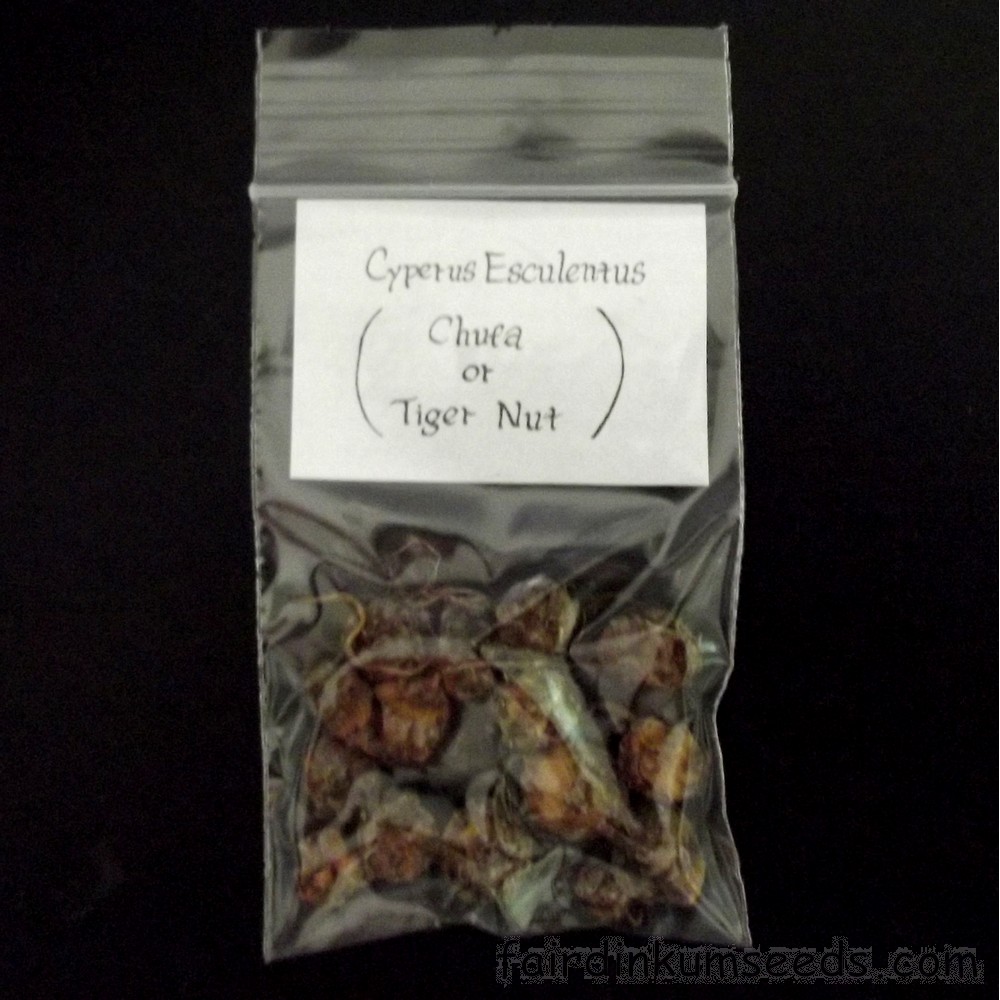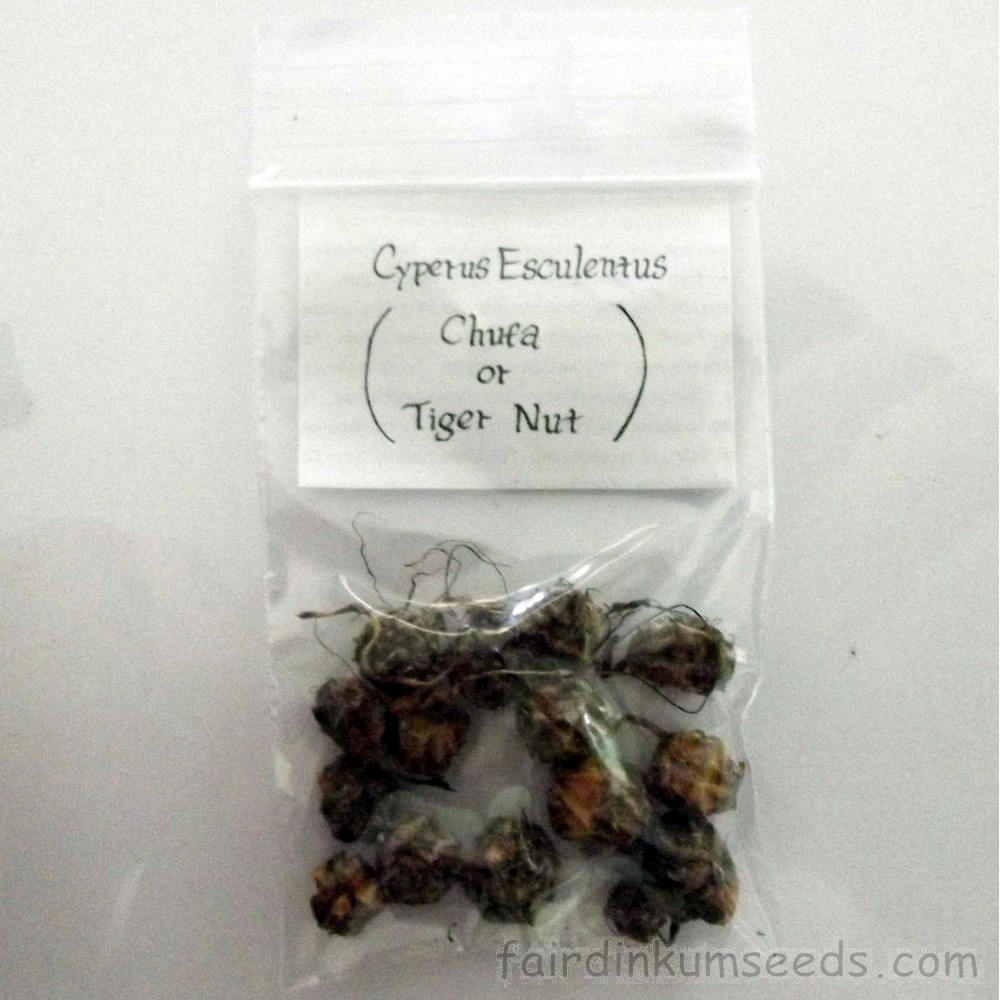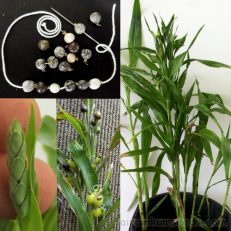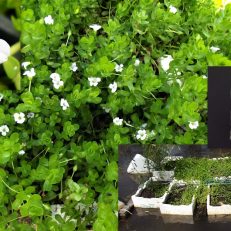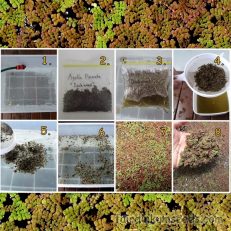Please read text!
Tiger Nut Earth Almonds Chufa Cyperus Esculentus Tubers
Packet of 10+ small semi-dried and dormant, tuberous roots.
I love this fella and based on very extensive experience I reckon this variety I am now growing is the very best of the lot.
At one time I had ten very different forms from growers all over the world.
Three types from Africa, two large and one incredibly small.
Four Spanish types, and two more from Canada plus this fella, Chufa de Valencia.
I grew them all for 3-5years in three very different environments and over time I got rid of the ones that didn’t perform well.
The two Canadian ones were very fibrous and struggled from the start so they were first to get the chop.
Two of the Spanish did good but the taste was not impressive, the other two died out completely, once from flooding and then later from the drought.
That just left the African ones. They handled the heat well and produced large tubers.
But unfortunately while Chufa de Valencia is not as big as the African ones were, the taste is much better and the yield is easy twice as big by weight.
I am so impressed with this one that last year I culled out all the others and replanted only these guys Chufa de Valencia.
A seriously under-utilised staple food crop, that is seriously easy to grow.
First of all it is important to note that they can sit dormant for months, especially when semi-dried like this, and that is normal.
Regular watering will swell the tubers and start the growth process, as will warm weather or just rain.
I have to admit I was a little worried when I first got given some as trade with a customer 6 years ago, as they looked shriveled and dry, and after planting absolutely nothing happened for 2-3months…
But, once they started they really took off.
I had them growing in polystyrene boxes and it wasn’t long before it was a carpet of green.
Fast forward a couple months later and the dog trashed all the boxes and ate the majority, but even so I was amazed at the amount of tubers per box.
I replanted what I could salvage, and this time fenced the boxes off so that the dogs couldn’t get at them, and that time I was averaging about 25%-50% of the volume of soil as tubers.
Each plant can produce several hundred tubers in good conditions, which means this packet is plenty to get you started.
You won’t get productivity like that from boring old spuds!
Tolerant to many different soil conditions including periods of drought and flooding and survive soil temperatures around -5°C to 45°C, no dramas at all.
The only thing to consider is the harvest.
Make sure you don’t have any rocks in your soil mix and it is seriously easy.
The best way to do things is using a bathtub, polystyrene boxes, tubs, pots or containers as it stops any escapees and makes harvesting them super easy.
Just tip them out on the ground, a large sieve, or just on the concrete and hit them with the hose to wash the soil away.
That is literally it.
Now they are ready to eat.
You can snack on them raw, or blended up with water as a “milk”, often called Horchata which is incredibly popular in Spain.
What is it actually?
Well it is a sort of grass really, except that underneath, all along the roots is these little tubers, pretty much the same as in a Peanut.
Very similar to the “Nut Grass weed” that proliferates in lawns down south except that this guy is an edible relative that has larger individual tubers.
This is not that guy, this is Cyperus esculentus NOT Cyperus rotundus, but even so, I am unable to send this guy to NSW, WA or TAS due to quarantine restrictions…
Sorry folks, I honestly believe it is based on a simple case of mis-identification, but unfortunately it is out of my hands.
Anyway, everyone else, you guys are in luck as this fella is awesome!
The problem stems from the fact there are so many places growing it as a food crop and they all have a different name for it.
Here are a few of them. Cyperus officinalis, Cyperus pallidus, Cyperus phymatodes, Cyperus phymatodes var. heermannii, Cuperus repens, Cyperus ruficomus, Cyperus scirpoides, Cyperus sieberianus, Cyperus tenoreanus, Cyperus tenorei, Cyperus tenorianus, Cyperus tuberosus, Cyperus variabilis, Pterocyperus esculentus, Pycreus esculentus, Chlorocyperus aureus, Chlorocyperus phymatodes, Cyperus aureus, Cyperus aureus, Cyperus bahiensis, Cyperus buchananii, Cyperus callistus, Cyperus chrysostachys, Cyperus cubensis, Cyperus damiettensis, Cyperus esculentus var. angustispicatus, Cyperus esculentus f. angustispicatus, Cyperus esculentus subsp. aureus, Cyperus esculentus var. cyclolepis, Cyperus esculentus f. evolutus, Cyperus esculentus var. heermannii, Cyperus esculentus var. helodes, Cyperus esculentus var. leptostachyus, Cyperus esculentus var. lutescens, Cyperus esculentus var. lutescens, Cyperus esculentus var. macrostachyus, Cyperus esculentus f. macrostachyus, Cyperus esculentus var. phymatodes, Cyperus esculentus f. princeps, Cyperus esculentus var. sativus, Cyperus esculentus var. sprucei, Cyperus fresenii, Cyperus fulvescens, Cyperus gracilescens, Cyperus gracilis, Cyperus heermannii, Cyperus helodes, Cyperus hydra, Cyperus lutescens, Cyperus melanorhizus, Cyperus nervosus, Cyperus esculentus, Bulbuli thrasi, chufa sedge, nut grass, yellow nutsedge, tiger nut sedge, or earth almond.
Thought to be the staple diet of our distant extinct relative “Paranthropus boisei”, or the “Nutcracker Man”, and there is evidence of cultivation by native American Indians 9,000 years ago.
Widely cultivated by the ancient Egyptians it was an important food during the dynastic times.
Dry tubers have been also been found in tombs from about 6000 years ago!
It was eaten boiled in beer, roasted, or as sweets made of ground tubers with honey.
The tubers were also used medicinally, taken orally, as an ointment, or as an enema, and used in fumigants to sweeten the smell of homes or clothing.
The plant was introduced to Spain by the Arabians, and they were also grown extensively in California, along with other countries like Guatemala, Mexico, Chile, Brasil, USA, Lebanon, Syria, Jordan, Saudi Arabia, Oman, Iran, Iraq, Pakistan, India, Yemen, Morocco, Ivory Coast, Sudan, South Sudan, Gambia, Guinea Bissau, Ghana, Niger, Nigeria, Burkina Faso, Togo, Benin, Northern Cameroon and Mali, where they are used primarily as animal feed or uncooked as a side dish, but in Hispanic countries they are used mainly to make horchata, a sweet, milk-like beverage.
As a source of oils, the tubers were used in pharmacy under the Latin name Bulbuli thrasi beginning no later than the end of 18th century and in Ayurvedic medicine tiger nuts are used in the treatment of flatulence, diarrhoea, dysentery, debility and indigestion. Tiger nut oil can be used in the cosmetic industry as it is a potent antidioxident and because of its naturally high vitamin E content it helps to slow ageing of the body cells. It favours the elasticity of the skin and reduces skin wrinkles.
Since the tubers of C. esculentus contain 20-36% oil, it has great potential for the production of biodiesel.
Soaked overnight, then boiled for half an hour then sundried they make a great fishing bait.
Just make sure they are totally dry and wack a little baggie full in your fishing tackle box for days when nothing is biting, or you can’t catch bait.
Doesn’t go off, doesn’t smell, and lasts forever.
Surprisingly effective too!
Used in England for carp but also works well for mullet, bream, whiting, perch, catfish when I had a crack at it. I’m sure it would work for other stuff too.
There you have it, another awesome tuberous vegetable crop.
Grown by me and the Mrs organically, no chems, no nasties, no problems!!!

